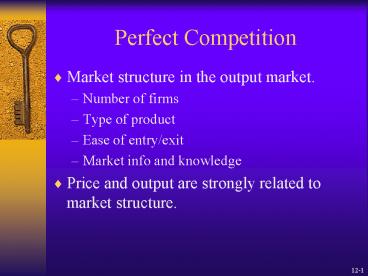Perfect Competition - PowerPoint PPT Presentation
1 / 14
Title:
Perfect Competition
Description:
Perfect Competition Market structure in the output market. Number of firms Type of product Ease of entry/exit Market info and knowledge Price and output are strongly ... – PowerPoint PPT presentation
Number of Views:199
Avg rating:3.0/5.0
Title: Perfect Competition
1
Perfect Competition
- Market structure in the output market.
- Number of firms
- Type of product
- Ease of entry/exit
- Market info and knowledge
- Price and output are strongly related to market
structure.
2
Perfect Competition
- Homogeneous or standardized product
- Enough firms so that each firm is small relative
to the market. Thus, no control over price. - No obstacles to entry and exit.
- Perfect info about product and market. Best
method of production market price. Also
potential entrants know whether existing firms
earn economic profits.
3
Firms Demand and Perfect Competition
- Since each firm is a price-taker, its demand
curve is horizontal at the market price. It can
also said to be perfectly elastic at the market
price.
P
S
P
D
P
P
D
Q
Q
Firm
Market
4
Firms Demand
- The firms demand curve in perfect competition is
also the - MR curve since each additional unit adds a
constant amount (Price) to Total revenue(TR) - Average Revenue curve since AR is TR/Q
5
Profit Maximization in the Short Run
MC
DMRP
MRMC
Q
Q
Remember FC is irrelevant in the Short Run. Old
MBMC Rule for Unconstrained Max from Chap. 4
6
Short Run Equilibrium for the Perfectly
Competitive Firm
- There are actually two basic cases to be
considered - Revenues (TR) covers variable costs(TVC). In
this case the firm produces where MRMC - If PgtATC, operate at economic profit
- If min AVC gtPltATC operate at a loss(but will
minimize loss) - Revenues(TR) is not able to cover variable
cost(TVC) at any level of output(Q). In this
case the firm should shut down (Q0). This
occurs when Plt min AVC.
7
Graphics for Previous Slide
- Refer to Figure 12.4, 12.5, and 12.6 in text plus
lecture drawings. - Note Figure 12.6 covers all possibilities by
assuming 3 different market prices(P1, P2, P3)
8
Short Run Supply in Perfect Competition
- The short run supply curve for the firm is that
part of the MC curve above AVC. (Figure 12.7)
MC
AVC
Q
9
Long Run Equilibrium in Perfect Competition
- In the LR, firms can freely enter and exit the
industry in response to market incentives. - Thus, if economic profits exist new firms will be
attracted into the industry. As the number of
firms increase, market Supply increases and
market price falls. As market price falls so
goes each firms demand curve (since price
takers) and the process continues til all
economic profit is eliminated.
10
Long Run Equilibrium in Perfect Competition
- See graphics in lecture and Figures 12.8 and
12.9. - LR equilibrium occurs when
P LMCLAC
11
Rent and Long Run Supply
- Economic rent is the payment to the owner of a
resource in excess of the resources opportunity
cost. - Firms that employ such productive resources earn
only normal profits in the LR because the excess
is paid to the owner of the resource. - Shaq receives huge rents since his income is far
in excess of his opportunity costs.
12
Profit Maximizing Input Usage
- So far have focused on profit max in terms of the
output to produce. - Need to also develop profit max in terms of input
usage. - Again this is an application of unconstrained
maximizing theory in which the solution is MB
MC. We just change names to fit the application. - MB increase in revenue generated by hiring an
additional unit of labor (will call MRP) - MC increase in cost due to hiring an additional
unit of labor (is the wage rate)
13
Marginal Revenue Product
- The marginal revenue product (MRP) is the
additional revenue earned when the firm hires an
additional unit of labor.
I units of the input MR marginal revenue MP
marginal product
14
14, page 472
MRP MR(MP)
MC w/MP
L Q MP MRP PL w MC Profit
1 5 5 10 10 2 -50
2 15 10 20 10 1 -40
3 30 15 30 10 0.67 -20
4 50 20 40 10 0.50 10
5 65 15 30 10 0.67 30
6 77 12 24 10 0.83 44
7 86 9 18 10 1.11 52
8 94 8 16 10 1.25 58
9 98 4 8 10 2.50 56
10 96 -2 -4 10 ------ 42
FC50































